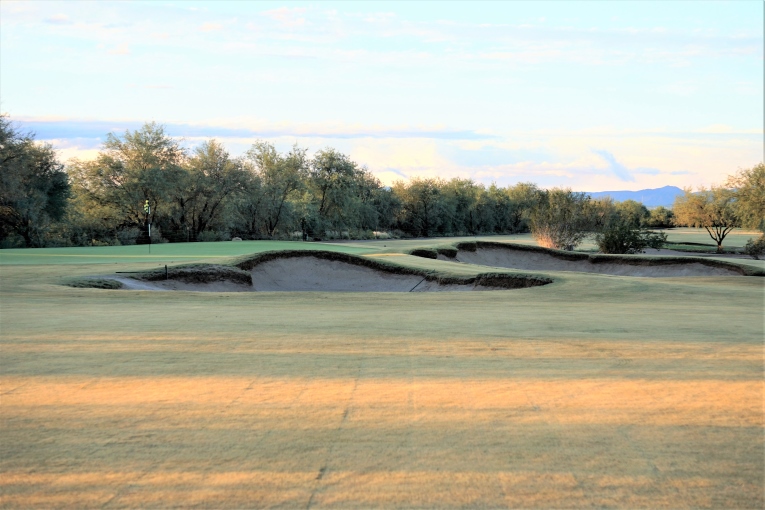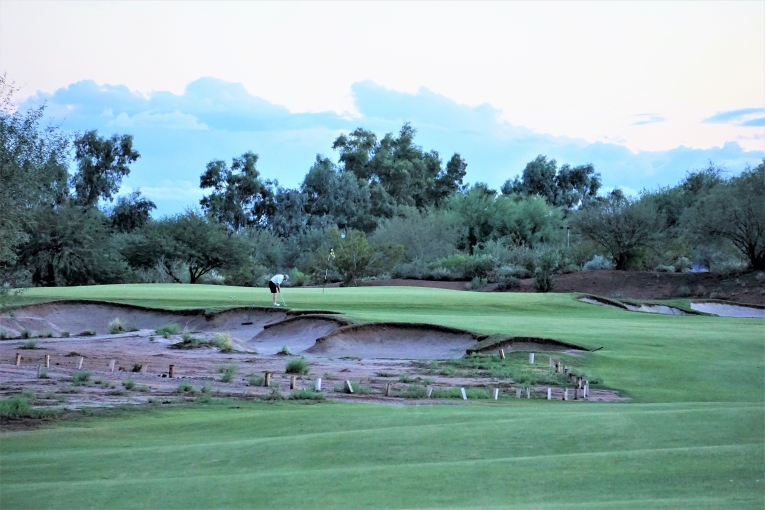Talking Stick Golf Club (O’odham Course)
Arizona, United States of America
GolfClubAtlas.com has come along way since it went live in 1999. Thankfully, it is internet based which means the course profiles are easy to update versus printed matter which is a fixed statement at a specific time. For instance, we wrote of Talking Stick North (now O’odham) in 2000 that, ‘If the authors were asked to show a course that illustrates the principles of minimalism, they would book airline tickets for Phoenix, Arizona. The North Course at the daily-fee Talking Stick Golf Club in Scottsdale not only shows what minimalism is, but it also demonstrates that an architect who knows his trade can build a first-rate, interesting course on a flat piece of land.’
While the gist might be correct, a few problems exist too. First, why not fly to Mullen, Nebraska and drive south? The same people who built Talking Stick had built Sand Hills two years before. Second, confusing a flat course that lays quietly on the ground with the epitome of minimalism is an honest mistake but it turns out that Talking Stick was quite the engineering effort. Both courses at Talking Stick were built within a flood plan and in order to allow water to flow through from the north, extensive work was required. True, the fact that the interconnecting low points and basins appear rooted in nature is one of the criteria of minimalism but … still, we did not give proper credit in the original profile for the novel, albeit unnoticeable, flood control system that was created. Third, Talking Stick possesses two courses built simultaneously by Coore & Crenshaw. We profiled the North over the South but over time, guess what happened? The North changed far more than the South. They are both fine courses but some of the praise written of the North in 2000 no longer applies as its playing characteristics have altered. The opportunity to update the eighteen year old profile is a welcome one.
To begin, Talking Stick occupies land within the Salt River Pima Maricopa Indian Community that is no different than thousands of square miles of land in the southwestern United States – flat and featureless. How flat? Bill Coore notes that you could stick a Coca-Cola can anywhere on the property and see it from over 400 yards away with a pair of binoculars. Now that is f-l-a-t. Indeed, when Dana Garmany of Troon Golf provided Coore with a topo map, the only thing on it was a ditch (which now parallels the seventh hole). Additionally, the property had another mark against it: it resided in a flood plan and as additional development occurred in the region, there was no doubt that more water would seek to sweep through it from the north. Therefore, the project out of necessity needed to be an exercise in engineered flood control with earth works required to control the path the water took across the property.

The 2nd fairway on the O’odham Course is a statement maker. It symbolizes creating interesting golf at grade as opposed to many other desert courses that feature mounding on the sides. Also, the perimeter holes were ‘calmer’ out of necessity while the interior ones were built up several feet as part of an elaborate waterway system.
On the plus side, scenic mountains act as a backdrop from many vantage points on the property. However, they are just that: scenery. Garmany was after two equal but distinct courses in part to act as a lure for people to spend the night at the well appointed resort hotel. Many architects would have felt compelled to move heaps of earth to ‘create’ character, but Ben Crenshaw and Bill Coore knew better, even in the first decade of their partnership. Built in 1997, the two courses at Talking Stick preceded many of the duo’s most famous designs including Bandon Trails, Friar’s Head, Old Sandwich, and Cabot Cliffs. However, it did come two years after Sand Hills, and much of the talent including Dave Axland, Dan Proctor, Jimbo Wright, and Jeff Bradley that brought you Sand Hills were present on this project too.
The decision was made early on that O’odham would be open and wind-sweep while Piipaash (formerly the South Course) would feature plantings and be more traditional in presentation. O’odham was built with wide fairways and greens that are generally extensions of the fairway, raised and crowned only slightly. Closely mown areas surrounded each green to allow the player to implement a ground game solution. This opportunity to play different type shots can befuddle the player as there is still doubt in his mind when he pulls the trigger as to whether he is making the proper decision (e.g. high or low). Yet, this effect leaves the course within the grasp of all players, a most desirable trait for a daily-fee course.
O’odham’s ground game options are the predominate reason that the GolfClubAtlas.com crowd prefers it to the next door Piipaash, which features built up green pads and was intentionally designed as more of an aerial exercise. Play is evenly spread but the typical resort guest is quicker to praise the Piipaash Course as they enjoy the conventional manner in which the holes are framed by handsome plantings and the resulting seclusion. Hindsight shows Garmany got what he wanted when the courses opened, but the passage of time has lessened those distinctions.
With time, the O’odham Course has morphed into something different than was originally intended. Perimeter and interior tree and shrub growth have made it more like its sister course. More importantly, thatch has accumulated (especially in that all important area twenty yards and in to many of the greens) and the ball no longer releases along its fairways like it once did. While the greens may be open, it is nonsensical to try a low running shot when inconsistent playing conditions offer a myriad of outcomes; might as well fly the ball onto the green for surety sake. Meanwhile, Piipaash plays pretty much as it always has, with aerial approach shots still de rigueur. Aesthetically, Piipaash remains similar in appearance to what it was on opening day. Sure, the plantings have grown but some have died as well and the net effect is still a mature park-like course in the desert.
When the author was here in October, 2018, O’odham had recently reopened after flooding from a monsoon. Sadly, O’odham was about to be over-seeded like Piipaash. The author fails to understand why facilities with two courses elect to over-seed both. After all, the marching orders to Coore & Crenshaw were to build two different courses, so why present them in a similar manner? Rye grass is slower than dormant Bermuda and O’odham needs to play fast and firm if its ground game options are to set it apart from Piipaash. Nonetheless, this profile retains its focus on O’odham, which the author thinks features a few more standout holes, and indeed a couple of holes that rival Coore & Crenshaw’s very best work, as we will see below.
Holes to Note
(Please note: The Black tees stretch the course over 7,100 yards but as is the policy of GolfClubAtlas, the distances below are from the Gold tees, which measure an ample 6,510 yards against a tight par of 70.)
Second hole, 510 yards, Pinnacle Peak, Kuvijk Do’ag; Coore calls this their ‘pay me now or pay me later’ hole and from the very start, it was ‘a hole that fascinated Ben and me. We built it though with the realization that it might well be misunderstood and sure enough it was. Back in those days, we were forwarded the comments from the Golf Digest raters and more than one considered it among the worst holes they had ever seen.’ In the yardage book, the hole looks ungainly – a monstrously wide fairway leading to a green off-center to the left. However, this width creates indecision on the part of the player as out of bounds extends tight left along the length of the hole. Two right greenside bunkers mean that if the player wishes to reach this green in two (a realistic goal) he must favor the left. All of a sudden, the fairway is not quite so wide. No doubt Tom Simpson, who adored the use of out of bounds as a way to rattle the player, would have been a huge fan of both this and the next hole. Coore & Crenshaw deserve as much credit for what they did (build at grade, width to assist the golfer in getting out of position) as for what they didn’t (eye candy, framing). Time has shown how adept the architects became in preying on the golfer’s greed. Countless examples abound but if the author was to compile an eclectic Coore & Crenshaw 18 hole course, this would be on it.
Third hole, 415 yards, Sand Hills, O’od Totonk; Perhaps the course’s most attractive hole as it plays into a corner of the property with the mountains beyond, the third enjoys a similar conundrum to the second. Out of bounds left and two greenside bunkers right create the tension. The preferred approach is from the left, and the architects create an illusion with a bunker down the left that must be carried from the tee to afford the player such an approach. Although it requires a carry of no more than 180 yards, the player often steers away from it at the last minute, potentially bringing the right fairway bunkers into play.

The third green is beautifully situated in a corner of the property; let’s hope the vegetation doesn’t continue to grow unchecked as Coore lined the hole up on the mountains for a reason. Plus, the reduction in sunlight and wind on the fairway doesn’t help it achieve the bouncy-bounce conditions that allow the design to flourish.
Fourth hole, 390 yards, Carry the Desert, Jevel I bei; Mindful that this is a daily-fee course, Coore & Crenshaw steered clear of relentlessly providing forced carries that would demolish the average player. Take the last hole for instance with the left bunker only ~ 175 yards from the tee. Nonetheless, given how they had to make allowances for transporting water across the property, several forced carries were mandated. Coore & Crenshaw do their part to help golfers overcome such moments as they occur from the tee with the golfer afforded a perfect lie/stance. This is one such moment as a flood control areas crosses diagonally between the tee and fairway. On the far side as part of a large sandscape, a dominant bunker pierces the fairway, creating a fork in the fairway that does a fine job of creating a multitude of playing angles. What registers to the golfer standing on the tee is that the challenge before him is appealing and reeks of good golf; he is likely oblivious to the functionality of the diagonal shallow depression before him as it is less than five feet in depth and is dry 99% of the time.
Fifth hole, 355 yards, Left is Right, O:gig o sape; The key to this hole lies in its name – ‘Left is Right.’ This short par four bends right and features a bunker smack in the middle of the fairway. As the hole flows right, the player instinctively assumes that the preferred line is right, as it represents the shortest way home. And yes, he would be wrong as the green is angled to accept an approach from the left. As proof that the architects have a sense of humor, the fourth on Piipaash is named ‘Right is Right’ for good reason. It is great to see a time honored design feature – in this case a central bunker – deployed on a daily fee course. Golfers sense too much pandering; ultimately, they want to be tested mentally and physically and this irritating feature does an admirable job of both.
Eighth hole, 145 yards, Short – Shortest Hole, Sopodk; Hindsight reveals when trends changed, or at least started to change. In 2018, courses are much more frequently judged by how artful their short holes are: short one shotters, drivable par fours and reachable par fives. In the mid 1990s, though, toughness remained a false god. Firms like Tom Doak’s Renassiance Golf Design and Coore & Crenshaw led the charge away from length for length’s sake and reintroduced variety into course design. This short one shotter with two glaring forward bunkers gives way to a pushed up green that falls away on all sides. It seems simple, right until your tee ball catches one of the green’s soft sides and is whisked away by the tight short grass. This hole, much like the seventeenth at Sand Hills that preceded it, was a harbinger of a more enlightened period of course design.

The tiny 8th at dusk. Today’s central hole location is straightforward but in general, this is no time to be greedy. Play to the middle of the green and putt out to the hole.
Tenth hole, 390 yards, New Beginning – Second Chance, Epoi I oidcu; With no natural features driving the routing, Coore was free to place the holes as he saw fit as opposed to connecting the dots/holes from one feature to the next. As it turned out, the feature that drove the placement of this playing corridor was seventeen miles (!) away in the form of the 3,169 foot tall Pinnacle Peak. Even the most self-absorbed player can’t help but appreciate his surroundings and the bunkerless green does nothing to distract the eye.
Eleventh hole, 215 yards, The Big Battle, S’Hasikam O Gevito; Long before they restored Pinehurst No.2, Coore & Crenshaw appreciated that hazards flush against a green can be limiting to a design’s appeal. After all, if a green is bunkered tightly left and right, there is no option/strategy other than to hit for the middle of the green. Repeated too often, the lack of thought will render the golfer less engaged and perhaps even feeling a bit hollow. Here at the eleventh, a large, George Thomas-style bunker is the focal point standing on the tee but in actuality, the putting surface doesn’t commence for 20 yards beyond it. Players are routinely deceived in judging the distance. The rolls around the green, particularly off the back-left corner, ensure that the player who plays ‘safely’ to the left will have work to save par.
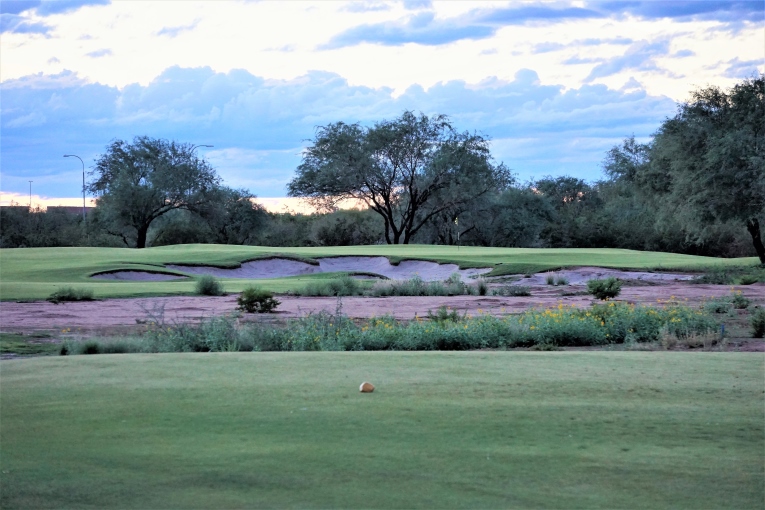
In a lot of ways, the 11th epitomizes the course’s overall design. Though flat, many options exist, including playing to the right where an up and down is more likely than one attempted from the left.
Twelfth hole, 360 yards, Red Mountain, Ve:ki Do’ag; A wash splits the fairway to great effect and for the first decade of play, created a fine gambling hole. By carrying the wash off the tee and seeking the left fairway between the wash and the boundary, the player could knock his tee ball within 60 to 90 yards of the green and enjoy a straightforward pitch down the length of the green. At least that was the intent. Now, twenty-one years after it opened, the left fairway is uncomfortably narrow with vegetation having closed in along the border. The slightest draw lands in the fairway and rolls effortlessly into the thicket to the point where heading left off the tee isn’t as realistic/tempting as it was meant to be. Regardless, it remains a fine two shotter as playing to the wide right fairway and pitching over the wash is not without appeal. One reason is that the wash itself is not death as being in it is usually no worse than having a marginal lie in a bunker. Hazards from which recovery is possible are infinitely more appealing than those from which it is not.
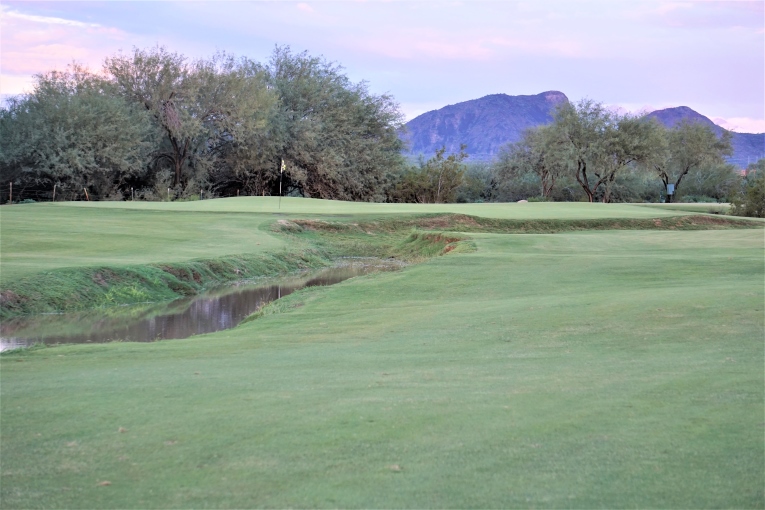
Coore & Crenshaw created this wash as part of an intricate system to move water across the course. It is dry most of the time but on this rain-soaked Saturday, it acted like it was supposed to by carting water from north to south.
Thirteenth hole, 350 yards, Left is Safe, O:gig o ma sape; As the name says, left is safe … but is it wise? As always with a Coore & Crenshaw design, a copious amount of fairway grass acts as a siren but the golfer is invariably better off to look for a hazard or something to challenge. Without doubt, the next shot will be easier if he successfully rubs past something versus taking the easy way out as proffered to him by the architects.

All the trouble is right off the tee but once the left greenside bunker is factored into the equation, middle right off the tee has merit.
Fifteenth hole, 425 yards, Cresote or Grease Wood, Segoi; Coore & Crenshaw do a remarkable job of keeping the golf engaging for eighteen holes over a flat site. That’s one of the reasons they accepted the job: to see if they could. Would they have wished for more (i.e. any) topography? Of course, as that is the surest way to give each hole its own voice. Nonetheless, here is an example where they artfully created a small land form seventy yards short left of the green. Left hole locations play peek-a-boo with the flag just visible beyond the hillock. The hill staggered with a right greenside bunker provide confusing optics, which isn’t something normally associated with a pancake flat site. Good for them for pulling out so many different tricks to make the golf more compelling than was the likely outcome from such a featureless canvas.
Eighteenth hole, 440 yards, That’s It, We Will See You Again, Dai Hegai, t’va epom nei!; The author’s favorite Home hole by Coore & Crenshaw is found at Kapalua Plantation, whose half par finisher has provided many indelible television moments over the years. Apart from that three shotter, many of Coore & Crenshaw’s Home holes are of the tough, two shot variety. There are a exceptions (including the sister course here and their course in China as well as other par fives at Streamsong and Clear Creek) but tough two shotters are the norm. The author’s very favorites of those is found at Lost Farms in Tasmania as it plays through mighty dunes and across roly-poly landforms. The other one that might rival it? This one. How neat that a daily fee course can conclude in a world class manner!
A distinctive aspect of both courses that set them apart from most Arizonan courses is that they are imminently walkable. Aside from being flat (and therefore easy to walk), there is rarely more than 50 yards from the green to the next tee. John Morrissett was once grouped with three players in carts, and several times he actually had to wait on the next tee for those players to roar up in their carts. Happily, they played their round in 3:40, another rarity for a daily fee course. All this contributes to what is frequently a wonderful golf experience.
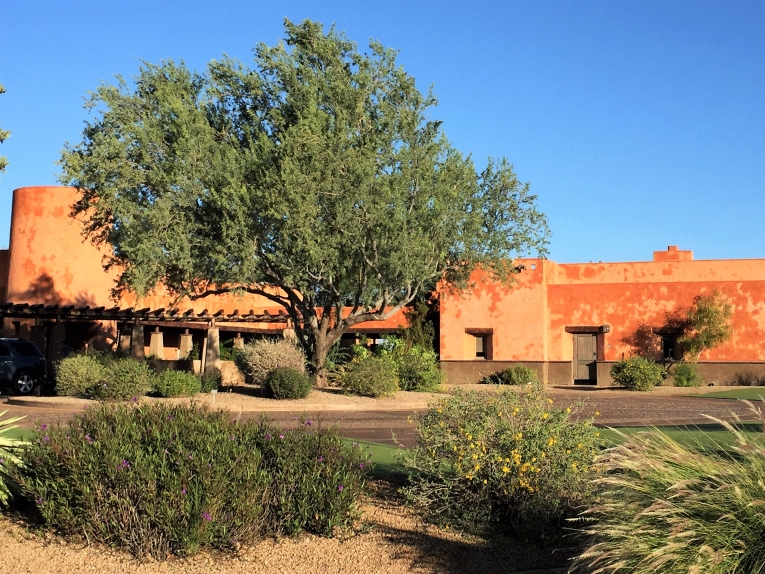
The attractive clubhouse sits in the middle of the property on a hill that was created in part so that the golf carts could be stored underneath the building.
Two more different opportunities could not have presented themselves relatively early in the career of Coore & Crenshaw than Sand Hills and Talking Stick. In fact, that challenge drove them to accept the Talking Stick project as they didn’t want to be pigeonholed as only capable of creating golf on perfect sites. The raw potential at Sand Hills was a “10” and the burden that fell on them was to not build an “8” or “9” course. The pressure on them at Talking Stick was just the opposite. The best thing going for it was that it enjoyed pretty surrounds and no homes that would intrude on play. Much to their credit, Coore & Crenshaw took a “1” property and made it into something far, far better. Both Sand Hills and Talking Stick are studies in what good architecture is all about, though for entirely different reasons.





